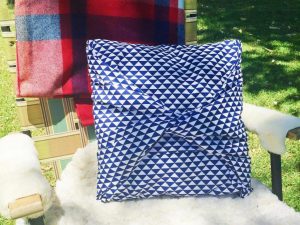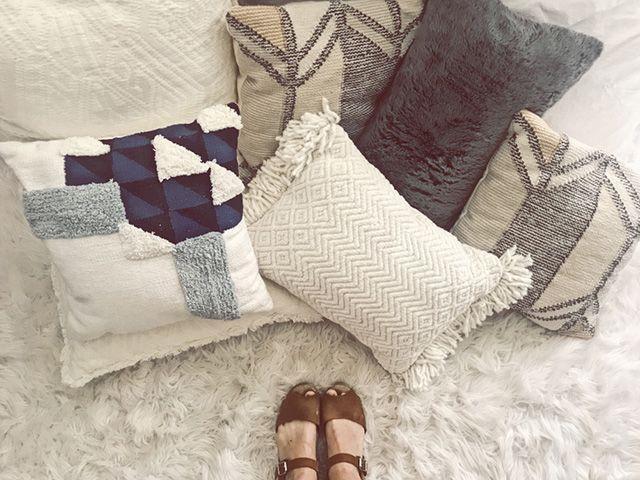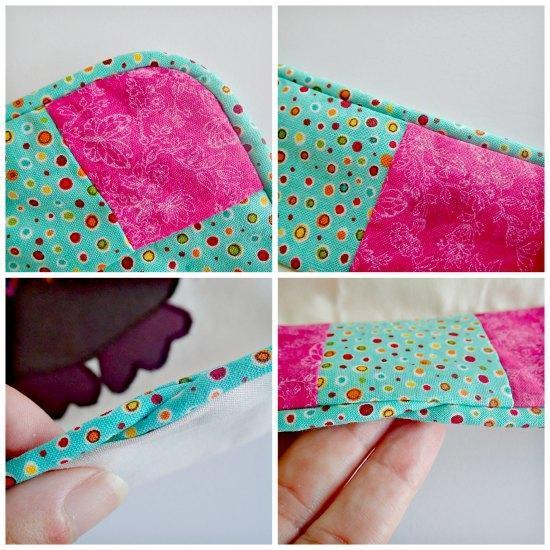Many people have never thought of sewing a pillow because of the numerous buying options in the market. Choosing to buy a pillow gives you the opportunity of finding what you need for your sleep and comfort needs. Another thing that probably deters people from sewing their pillows is the agony of looking for the filling materials.

Sewing a pillowcase, on the other hand, is easy, and with a sewing machine, you can create different and beautiful pillow covers. In this article, we take you through the simple steps of sewing a pillow you can use as you sleep, a throw pillow, a piping on a pillow and a pillow cover. We will also take you through on how to sew a zipper on a pillow.
See also:
[su_note note_color=”#f2f6d3″]
[/su_note]
Step-By-Step Guide On How To Sew a Pillow
Requirements
- A sewing machine
- Piece of fabric
- A pair of scissors
- Pillow filling
- Pins
- Thread
- Measuring tape
Method
Before you start working on the pillow, you should make sure that you know the size that you desire.
- Take the piece of fabric and cut it into two sections. The material that you cut should be longer and broader than the size you desire by one and a half inches, respectively. If you cover your finished pillow with a pillowcase, choose a plain colour, preferably white. If you want to leave the pillow as it for decorative purposes, choose a material with some decorative patterns.
- Pin the sides of the fabric together, leaving the top side open
- Using a straight stitch, sew through the pinned materials ensuring that you leave a seam allowance of 5/8 inches. Sew across all the sides and pivot the material at each corner with the sewing needle facing downwards. When you reach the bottom edge of the side of the pillow, stitch each corner towards the centre. Leave an unsewn opening measuring 4 inches and get rid of the pins.
- Ensuring that you keep the corners from bunching by clipping them cut an eighth off outside the corners. Turn the material inside out by reaching into the 4-inch opening.
- Take your pillow filling and separate them into smaller pieces to avoid clumping. Using the 4-inch opening, stuff your filling into your pillow by filling up all the corner first. After you finish with the corners, start stuffing the body of the pillow.
- After you are sure that the filling is enough and the pillow satisfies what you desire, fold the opening to align it with the other edges. Close up the opening by using a hand-sewing needle. Remove any other pins remaining and cut all the loose hanging threads.
Now that you have your pillow, the next step will be to make a pillow cover if your pillow is not for decorative purpose. Below is the step-by-step guideline o how to make the pillow cover.
[amazon bestseller=”pillow case”]
How To Sew a Pillow Cover

Requirements
- Measuring tape
- Pillow
- Pillow cover fabric
- Pins
- Sewing machine
- Ironing board
- Thread
- Iron
- A pair of scissors
Method
- Using a measuring tape take the length of your pillow by following the loft.
- Use the same measurements to cut the length and width of the pillow cover. Ensure that you add an inch to the length and about four inches to the width of the pillow if you opt to buy a readymade pillow cover instead of sewing one.
- If you are using a hand or washable machine fabric, wash, dry, and iron it first before you start sewing. If you are using a material with the label dry clean only, skip the washing, drying and ironing step.
- Once your fabric is all dry and neat, cut it into two pieces. It should be two and a half inches long and five and a half inches wider than the pillow. If the material you choose to use for the pillowcase has a pattern, ensure that you cut in such a way that the design looks and faces the same direction on both pieces of the material.
- With the wrong sides of the material facing up, pin all the sides together.
- Using a straight stitch, sew the fabric pieces together along one side, the top, and the bottom. When you are stitching the sided of the pillowcase, leave a seam allowance of a quarter inch. If you are making a rectangular pillowcase, the part that you leave open should be the shortest side. If you are making a square pillowcase, you can choose to leave any side open.
- Once you finish stitching up the three sides, trim the edges. When cutting the edges, ensure that you keep a distance of an eighth from the stitching.
- With the wrong side out, iron the pillowcase and hold all the seas flat by pinning along the sewn sides.
- Using a 3/8 seam allowance straight stitch the three sides to create a French seam that helps to hide all the raw edges. A French seam also helps to prevent the seas and fabric from raveling. Once you finish, remove all the pins, flatten the French seams by ironing, and ensure that they rest against the material flatly. Take half-inch fold and iron it around the opening, ensuring that fabrics wrong side is on the inside part of the fold.
- Sew the folded hem using a straight stitch, ensuring that you have a quarter-inch between the inside edge of the fold and the seam line.
- Remove all the pins, turn the pillowcase right side up, and finish by ironing the completed piece.
- Using the hemmed opening, insert your pillow into the pillowcase.
How to Hand Sew a Pillow and a Pillow Cover
For a hand-sewn pillow cover, you do not need any sewing machine but just your hands and the other requirements that include the fabric, a pair of scissors, pins, needle, thread, filling, iron, and ironing board.
Method
You will follow the same method of how to sew a pillow, but instead of using a sewing machine, you will use a needle and thread instead. The same applies for the pillow cover.
How to Sew a Zipper On a pillow

It is easy to make a pillow with an invisible zipper from the comfort of your home. The materials you will need for this are a zipper, fabric, a filled pillow, pins, sewing machine, zipper coot, scissors, and a seam ripper.
Method
Before you continue, ensure that your pillows back and front are equal in size.
- Attach the zipper foot to the sewing machine.
- Iron the zipper coils and take care not to melt the polyester coils.
- With the right side facing up, lay your pillow on the work surface. Place your zipper on the pillows bottom edge, making sure that the coils face towards the pillows centre and the right side faces down. Use the ruler for precision.
- Anchor the zipper in place with pins.
- Using the backstitch, Start sewing from the first pin to where the zipper coils stop.
- With the right side facing up, lay the pillow back on the work surface.
- Place the unattached side of the zipper to the right side of the pillow and repeat the same process as the last part.
- Close the zipper and lay your pillow covers together with the right sides facing each other
- Place the pins on both sides of the zipper to make it flat and stable.
- Align all the corners of the pillow and pin them.
- Open the zipper and stitch the pillow together using backstitch, ensuring that you keep a space of half an inch between the edge and the seam line.
- Clip the corners, cut any hanging threads, and turn the pillow cover, so the right side faces up. Poke all the corners of the cover out and press it. Stuff your filling, and there you have your zippered pillow.
How To Sew a Throw Pillow

Making a throw pillow is fun, as you do not have to go with a standard size. You can make a throw pillow that best suits your preference and comfort by following the same procedures of making a pillow.
[amazon bestseller=”throw pillow” items=”3″]
How to Sew a Piping on a Pillow

A piping on ta pillow adds to its beauty and durability. Sewing piping is also one of the most natural things to do.
Requirements
- Pillow fabric- 2 pieces
- Piping
- Pins
- A pair of scissors
- A zipper foot
Method
- Prepare the pillow pieces and pin the piping on one of the covers to the outer edge
- Ensure that the piping is on the seam allowance of the pillow
- Pin the piping around the edge of the pillow, leaving some of it unpinned. Ensure that you work the corners as perfectly as you could
- Sew on the piping using a zipper foot by ensuring you do it against the round part of the piping.
- Stitch slowly along the corners and try to make them as round as you possibly can
- Take the unpinned extra once you finish stitching all around the pillow and overlap it on the beginning of the piping to create a c shape.
- Trim off any extra piping
- With the right side facing each other, place the second layer of fabric on top of the first
- Pin the outer edges in place
- Sew the pieces together and trim the corners when you finish
- Turn your pillow inside out, poke the corners out and you can enjoy the final look of the piping on your pillow.
Wrapping it up
For people that love sewing and DIY projects, sewing a pillow from scratch is a fun thing to do. Sewing your pillow and pillow cover also allows you to be more creative to come up with your designs and sizes for others the concept of making a pillow on their own is hard. Fortunately, you have the market to thank for the most extensive choices of different pillows.
[amazon bestseller=”pillow cover”]

![Top Rated CPAP Machine Buyer’s Guide [current_date format=’m/Y’]](https://bestpillowsleepers.com/wp-content/uploads/2023/03/best-cpap-machine-img_6405d72310053-400x300.jpg)
![The 11 Best Cooling Weighted Blankets [current_date format=’m/Y’]](https://bestpillowsleepers.com/wp-content/uploads/2023/01/best-cooling-weighted-blankets-img_63d4ff15c615d-400x300.jpg)
![Ultimate Guide to Choosing a Best Cooling Mattress Pads [current_date format=’m/Y’]](https://bestpillowsleepers.com/wp-content/uploads/2023/01/best-cooling-mattress-pads-img_63c403115126b-400x300.jpg)
![Ultimate Guide to Choosing a Best Cooling Mattress [current_date format=’m/Y’]](https://bestpillowsleepers.com/wp-content/uploads/2023/01/ultimate-guide-to-choosing-a-best-cooling-mattress-img_63bcdba870d77-400x300.jpg)
![Ultimate Guide to Choosing a Best Cooling Comforters [current_date format=’m/Y’]](https://bestpillowsleepers.com/wp-content/uploads/2023/01/ultimate-guide-to-choosing-a-best-cooling-comforters-img_63bba2f5cd3ce-400x300.jpg)